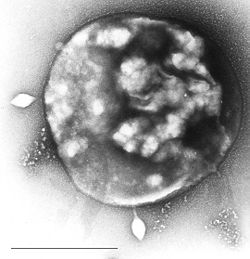| Sulfolobales | |
|---|---|
 | |
| Electron micrograph of Sulfolobus infected with Sulfolobus virus STSV1. Bar = 1 μm. | |
| Scientific classification | |
| Domain: | Archaea |
| Kingdom: | Thermoproteati |
| Phylum: | Thermoproteota |
| Class: | Thermoprotei |
| Order: | Sulfolobales Stetter, 1989 |
| Family | |
Sulfolobales is an order of archaeans in the class Thermoprotei. [1]